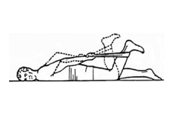EXERCISES AFTER ACL SURGERY
After ACL injury: After ACL tear rehabilitation primarily aims at reducing swelling and restoring range of motion. This can be achieved by applying ice every two hours for 20 minutes for 2-3 days. Reduction of swelling helps the return of range of motion. Once your pain and swelling subside, start doing range of motion exercises (Ex. no 1to 5 given below). Surgery can be done once swelling goes down with return of normal range of motion. It may take 2-3 weeks after injury.
About The Surgery
This surgery aims at restoring the stability of knee joint by reconstructing the torn ACL ligament using your hamstring tendons. Hamstring tendons are harvested by a small incision on your leg below the knee. Rest of the surgery is done by putting a small camera (arthroscope) through a key hole and instruments by another key hole. Graft is put through a tunnel into the thigh and leg bones and fixed with a biaborbable or titaneum screw on leg side and a small button on the thigh side.
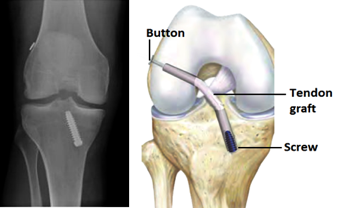
AFTER THE OPERATION:
After surgery your knee will be supported on a brace and you will be shifted to ward/room. You have to wear knee brace for next two weeks. In the first week main aim is to keep the pain and swelling minimum. To achieve this, remove brace and apply ice (ice packs) to the knee every 2-3 hourly for 15-20 minutes. Keep ice packs into a poly bag and apply directly over the dressing. Keep the limb elevated over one or two pillows. Knee brace is removed while doing exercises and worn again.
IT IS IMPORTANT TO KEEP THE INCISIONS DRY UNTIL THE STITCHES ARE REMOVED. Stiches are removed 12-14 days after surgery.
Do not sit for long time (except doing exercises) with legs hanging at the edge of table/bed to avoid swelling of knee and leg. A little swelling around knee joint is usual after surgery.
Hamstring tendons are harvested during surgery which takes 6 weeks to heal. Don’t overstretch the hamstring muscle during this period. Avoid lean forward with knee straight to pick an object off the floor or to put on socks/shoes.
Ambulation
Use crutches/walker for first two weeks and bear weight through operated knee as tolerated as possible. Wean off braces after two weeks.
Frequency of Exercises
3-4 times per day, unless otherwise indicated.
Important questions and answer:
- When can I assume my work again?
Desk type job can be assumed after 1 month. Policemen, army firemen, construction workers, laborers, will be out of work for a minimum of 6 – 12 weeks.
- When can I drive a car?
Driving can safely be assumed when you regain range of motion and normal reaction time. Typically it takes 4-6 weeks. You can ride road bikes after 12 weeks.
- When can I use stairs?
As soon as you achieve normal range of motion, that is sufficient to climb stairs. This may take 2-3 weeks.
- When can I assume running?
Straight line jogging at 2 months and running at 3-4 months
- How long is physical therapy?
The ultimate goal of therapy is to develop strength so that you get back to sports again. Typically it takes 6-9 months and a dedicated exercise program is required for 6 months. It is recommended that you join a gym after surgery because many exercises require gym machines.
- How long is the surgery?
Surgery may take 1-2 hours depending upon the presence of other injuries (meniscus or other ligament injury)
Post-operative rehabilitation protocol:
0-2 weeks: Weight bearing as tolerated. Begin walking with use of the crutches/walker. During this period aim is to restore normal range of motion. Start doing these below mentioned exercises:
- Heel props: Place the heel on a rolled towel and press into it for 5 seconds then allow the leg to relax into extension for 5 seconds. Do this exercise every waking hour for 10 minutes. This helps to achieve full extension (straight leg).
- Prone hang exercise. Lie face down and Hang your legs off the table. You can keep a rolled towel under your thigh as shown in the picture. Do this 3-4 times a day for 2-3 minutes at a time.
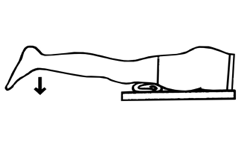
You may do either exercise 1 or 2. It is not necessary to do both exercises.
3. Passive flexion – Sit on the edge of bed/chair and bend your knee as much as possible. Take help of other leg to bend your operated leg. . Hold for 5 seconds after pushing and then relax for 5 seconds. Do this 3-4 times a day for 5 minutes at a time.
- Heel slides: Sit on the bed and try to pull the heel toward the buttock with the help of a belt /scarf as shown in the picture below. Hold for 5 seconds after pulling and again straighten the leg by sliding the heel away from buttock. Again hold the straight leg for 5 seconds. Do this 3-4 times a day for 5 minutes at a time.
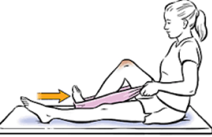
- Stationary bicycle riding: Start stationary bicycle 10 minutes a day between 7-14 days or when your knees flex to more than 90 degrees. Gradually increase by 2 minutes per week till 20 minutes per week. Progress in this manner: high seat ½ circles forward/backward (pendulum exercises) to full circles – lower seat. Initially start without resistance and gradually add resistance by the end of 4 weeks.
(Swimming can also be started at this time)
These Above mentioned five exercises will help you regain range of motion as fast as possible.
Strengthening exercises
1. Quadriceps isometrics exercises: In lying position keep a rolled towel under your knee and push into it. Hold for 10 seconds and then relax for 5 seconds. Do three sets of 10 repetitions.
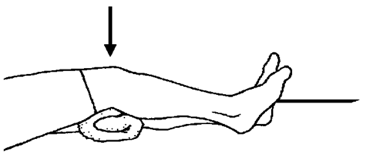
- Mini wall squat (30°): Place feet at shoulder width. Initially you can take support of a wall and squat up to 30 degree. Hold for 10 seconds and then relax for 5 seconds. Do three sets of 10 repetitions.
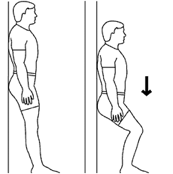
- Static lunge forward/side: Hold for 10 seconds and relax. Do 10 repetitions two times a day.

- Heel raises: Hold for 5 seconds and slowly get down. Do it 3 times a day with 10 repetitions each time.
- Hip exercises: Hold for 5 seconds then relax for 5 seconds. Do 3 sets of ten repetitions.
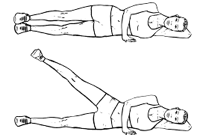
- Side lying abduction/adduction
- Prone hip extension
- Standing hip flexion/extension, abduction/adduction
Proprioception exercises: These are balance exercises which help you don’t get injured again.
- Single leg stance 30-60 seconds: Stand on both your operated and healthy leg one by one. Do two sets of three repetitions. Progress to same exercise with closed eyes.
- Wobble boards standing: Progress from double leg stance to single leg stance at 4 weeks. Take support of table or bar initially in first 6 weeks. After 6 weeks stand on wobble board without support.
You may find wobble board at your nearest physiotherapy centre. If you cannot access to physiotherapist then here are some home based balance exercises (given below).
2-6 weeks
Now you can walok without braces and without crutches/walker.Contiue above mentioned exercises with addition of more intence strengthening exercises.
1. Prone flexion. Lie face down on the bed and bend your knee. You can take help of other leg or a belt/elastc belt to bend your operated knee. . Hold for 5 seconds after pulling and again straighten the leg and relax for 5 seconds. Do this 3-4 times a day for 5 minutes at a time.
- Hamstring isometric exercises: Start at 4 weeks.
Sit with leg slightly bent and without moving leg, try to push heel down. Hold it for 10 seconds and then relax for 5 seconds. Do 10 sets three times a day.
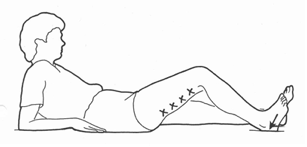
- Open chain weighted quad extensions from 90 – 30 degrees: Hold for 10 seconds. Avoid terminal knee extension while straight leg raising as it may strain the newly constructed ligament. Do 10 sets, three times a day.
- Leg press: These exercises help building your quadriceps (front of thigh muscles).You can find leg press machine at a nearby gym. Start with minimum weight and gradually increase weight 2-3 kg per week. Do 10 minutes a day. Once you are comfortably lifting weight you can progress to single leg press after 2-3 weeks.

- Leg extension: This also builds up your quadriceps (front muscles of thigh). Start with minimum weight and gradually increase weight 2-3 kg per week. Do 10 minutes a day.
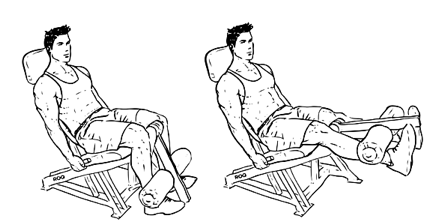 You can choose either leg press or leg extension (Exercise 4 and 5). As both build up your quadriceps (front muscles of the thigh).
You can choose either leg press or leg extension (Exercise 4 and 5). As both build up your quadriceps (front muscles of the thigh). - Stairmaster: You can exercise buttock, thigh and leg muscles with this machine in a gym. This is also good for core strength and aerobic exercises. Start with 10 minutes a day and increase up to 20 minutes a day.
- Hamstring curls: This strengthens back muscles of the thigh. Start this exercise at 6 weeks because your graft has been reconstructed using hamstring tendons which need 6 weeks to heal. Do hamstring curls in sitting position and not in lying face down position. Start with minimum weight and gradually increase weight 2-3 kg 4per week. Do 10 minutes a day. Gradually increase to20 minutes. If you develop hamstring pain (at back of your thigh and knee) then decrease the intensity of exercise.
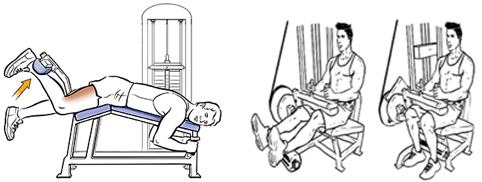
- Elliptical cross trainer: 20-30 minutes a day: This strengthens your hamstrings, quadriceps, calf muscles and also a good work out for upper limb muscles
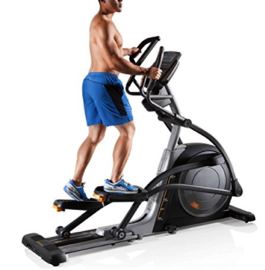
- Squat: Squat up to 600 hold for 10 seconds and then relax for 10 seconds. Do three sets of 10 repetitions.
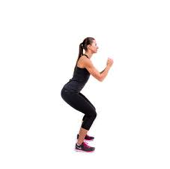
- Core body strength: This is particularly important for athletes to enhance performance of physical activities and to reduce re-injury rate. Core is comprised of abdominal, back and pelvic muscles. Strengthening core is of fundamental importance for athletic movements.I.) Abdominal isometrics: Lying on your back or standing, draw your stomach muscles in and hold for 10 seconds, repeat 1-3 sets of 10-15 repetitions.
II.) Crunches: Lie on your back with the knees bent and feet flat on the floor. Keep arms by your side or across the chest. Tighten your abdominals by drawing them into stomach and slowly curl upper back, shoulders, and head 5-10 inches away from the floor, hold for a few seconds. Return slowly to the floor and repeat. Do 10-15 repetitions.

III.) Reverse Crunches:Lie on your back with the arms by your side. Draw your stomach in, bend your knees and slowly curl your lower back and hips 4-6 inches off the floor and towards your chest. Hold this position for a few seconds. Return slowly to the floor and repeat 10-15 times.

Proprioception exercises: Continue with proprioception exercises mentioned earlier and add these following exercises:
- Single leg toe raises: Hold for 5-10 seconds and do two sets of 10 repetitions.
- Single leg balance, eyes closed: Hold for 5-10 seconds and do two sets of 10 repetitions.
- Single leg balance with various positions of head, arm and trunk: Hold for 5-10 seconds and do two sets of 10 repetitions.
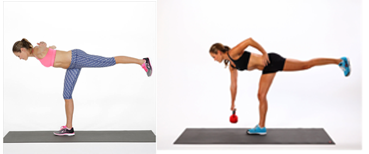
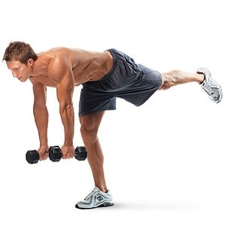
Hip resistance exercises: Use theraband / resistance band for the hip exercises you were doing before. This will strengthen your hip muscles. Hold for 5 seconds then relax for 5 seconds. Do 3 sets of ten repetitions.

- 6-12 weeks: Continue with quadriceps sets, partial squats, toe raises, stationary bike, elliptical machine, leg presses, and leg curls with addition of these exercises:
- Full squat can now be started (90 Degrees).
- Open chain quadriceps (sitting) can be increased up to zero degrees (sitting on a chair with legs hanging and now straighten both legs fully up to zero degrees.)
- Open chain quadriceps (lying): In full extension contract thigh muscles. This will lock knee and prevent excessive stress from being applied on the ACL graft. Now lift the leg up to 45 degrees and hold it for 10 seconds. DO two sets of ten repetitions.
- Cardiovascular fitness: Start treadmill (flat only). Jogging can be started at 2 months (straight line, flat surface). Start with 1 km a day gradually increase by 500 meters per weak within limit of pain and swelling.
12- 24 weeks: Continue all strengthening exercises and start agility drills at 3 months:
Agility Drills: Agility is one’s ability to change direction or position as quickly and effectively as possible. This is very important demand during sport activity. This gives confidence to get back to sports again and also help prevent re-injuries. Following are a few simple agility drills:
- Backward running: This is an effective drill particularly for sports requiring strength and endurance of the gluteal (buttock) and calf muscle (leg) groups. Start at slow speed and gradually increase the speed. Run for 50-60 meters and do 5-10 repetitions.
- High Knee Drills
While running lift knees as high as possible. Run for 30 seconds. Repeat two times a day.
- Vertical Jumping
Stand with your feet at a shoulder distance and bend your hip, knee and ankles until knee are flexed to 90 degrees. Now jump as high as you can. Land gently with knees slightly bent. Repeat 15 – 20 times.
- Carioca
During carioca drill you move sideways at fast speed or run sideways. Move your right foot crossing front of your body and to side of left foot. Then move left foot to side of right foot. Now move right foot crossing behind the body and to side of left foot. Thus with every step you move sideways. Move/run to 30-40 meters.
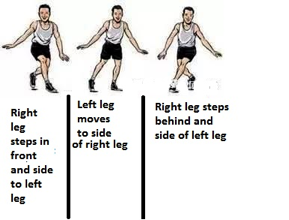
CUTTING DRILLS:
- Run and Cut
Run at moderate speed for 10-15 meters straight, plant on the right leg and turn to change direction to left and then run again. Repeat 15-20 times.
- Figure of Eight drill
Run a figure of eight pattern at moderate speed for 30-40 meters. Repeat it for 15 times. Gradually reduce the size of “8” and increase your speed as you progress. It is very helpful for developing “run and cut” skills in field sports.
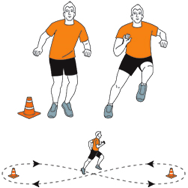
6-12 months:
Sport Drills
The athlete may begin drills specific to the sport (i.e., football, basketball, baseball, etc.)
You can return to sports after 6-9 months
ABOUT THE AUTHOR

TESTIMONIAL

मेरा दाए पैर में चोट लगने के कारण टेढ़ा हो गया था जिसकी वजह से मुझे चलने में भी परेशानी हो रही थी. डॉ जितेश ने ऑपरेशन कर के इसे सीधा किया. में बिलकुल ठीक हूँ .

मेरी बेटी के घुटने में इन्फेक्शन होने के कारण वो दर्द की वजह से सो भी नहीं पाती थी. डॉ जितेश ने ऑपरेशन कर के इसे ठीक किया. बहुत धन्यवाद।

I remember that Dr. Jain came out from his clinic to see my mother because my mother was not able walk a single step. He did total knee replacement on both side and now my mother is walking without aid.
OPENING HOURS
| Monday – Friday | 17:00 – 20:00 |
| Sunday | OFF |








